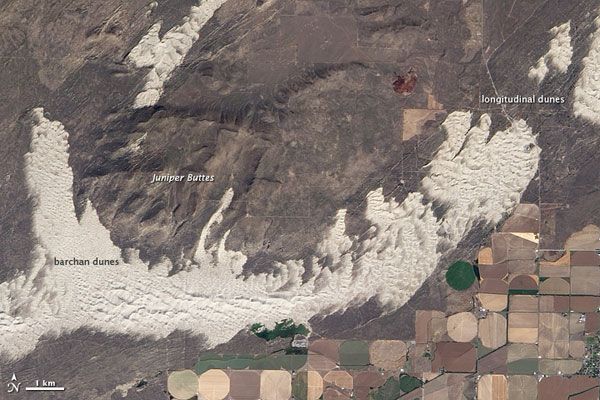
Idaho's Out-of-Place Sand Dunes Reveal Past Climates

While traveling through Idaho toward Wyoming, the last thing you would expect to see are white sand dunes, similar to those found in the Sahara Desert, but they are there, right outside a small town called St. Anthony.
The out-of-place dunes hint at a time when the climate of eastern Idaho was far different than it is today.
The sand dunes spill across the Snake River Plain in a wide arc in this image acquired by NASA's EO-1 satellite on Sept. 25. Freshly harvested fields line the southern boundary of the dunes, and to the north is a darker, brush-covered lava plain.
The light-colored dunes formed about 10,000 years ago, at the end of the last ice age when the Earth's climate shifted. Eastern Idaho's climate became warmer and drier. Lakes shrank, exposing fine sand. Persistent winds from the southwest blew the sand northeast across the lava plain visible in the lower left corner of the image.
Dunes form only when sand encounters a soft surface or obstacle that prevents it from blowing away. The St. Anthony Dunes began to form when the sand reached the weathered mass of the Juniper Buttes, extinct volcanoes . Each individual dune forms a curve. This type of dune is a barchan dune ("barchans" is Arabic for "ram's horn").
East of the volcanoes, the sand is kept in place by older dunes. These longitudinal dunes are plant-covered sand dunes that formed in a previous, more arid climate. They formed on top of an old flood plain, from a branch of the Snake River. The longitudinal dunes are long, dark stripes under the newer, brilliant white dunes layers of climate history visible at a glance.
As for the circular crops, they were not created by any alien life forms. In an attempt to save water, farmers have begun to use central pivot irrigation. Long pipes perched on wheels rotate around the pivot, showering the crops with water so that less is lost to evaporation and more goes to nourishing the growing plants. Central pivot irrigation also creates perfectly circular fields, as seen in this image.
Sign up for the Live Science daily newsletter now
Get the world’s most fascinating discoveries delivered straight to your inbox.
- 101 Amazing Earth Facts
- Image Gallery Observing Earth: Amazing Views from Above
- This Is Not Mars













